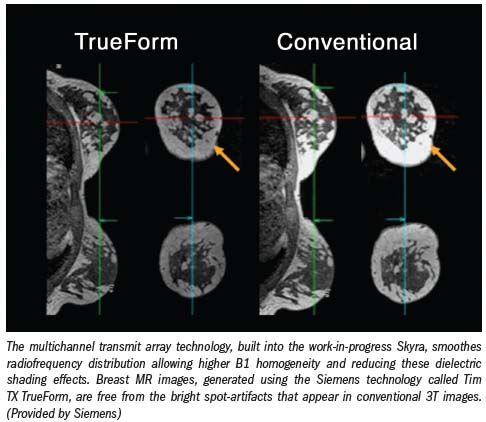- AI
- Molecular Imaging
- CT
- X-Ray
- Ultrasound
- MRI
- Facility Management
- Mammography
Siemens adds MR transmit channels to boost function
In the last decade, the number of receive channels available on MR scanners has ballooned from one to 128.
In the last decade, the number of receive channels available on MR scanners has ballooned from one to 128. Future systems are being designed to allow even more. Increasing the number of channels dedicated to receiving signals has increased the speed at which scans can be performed. But this is only one side of the coin. The other is the transmit side, where increasing the number of channels offers different advantages. Siemens is doing just that, boosting the number of transmit (TX) channels in its TX Array technology.
The currently available commercial version of the technology offers two transmit channels rather than the one classically built into scanners. This technology enables higher B1 homogeneity, which reduces the dielectric shading effects that can appear, especially at field strengths of 3T and higher. While present at 1.5T, dielectric shading effects can get much worse at higher field strengths, producing bright spots in images that can obscure pathology.
Siemens has proven the technology, building it into the company’s 3T Magnetom Vario since 2007 and the work-in-progress 3T Skyra commercial flagships unveiled at last year’s RSNA meeting. The names are slightly different, TrueForm RF on the Vario and TimTX TrueForm on Skyra, but they do much the same thing: speed acquisitions and improve image quality. And what they can do now barely hints at what is to come.

In a kind of trickle-up evolution, Siemens is adapting the technology for use in its 7T scanners. At this ultrahigh field strength, the TX Array may comprise eight or even 16 transmit channels, enabling new applications, such as organ- or volume-specific excitation.
About 20 clinical sites are working on novel applications that might be possible through the use of multiplechannel TX Arrays. The most promising possibilities come from the ability to excite specific parts of the body.
“We expect this will speed up acquisition and get rid of many artifacts,” said Walter Märzendorfer, CEO of Siemens MR. “Because of the specific excitation, no signal will come from outside the volume that was excited.”
But TX Array technology may go further, changing the very strategies that underlie clinical imaging. With this technology, radiologists may be able to drill down to specific regions of interest: the kidney, the heart, or just part of a blood vessel and its surrounding tissue.
“You might be able to see perfusion in tissue perfused by just this single vessel,” Märzendorfer said.
These capabilities will appear first at the fringes of MR imaging, in ultrahigh field MR scanners. But their clinical potential might ultimately be realized in the 3T systems where TX Array technology first took hold.
“It is really a holistic research collaboration program,” Märzendorfer said. “Based on the output of this program, we will choose specific elements and, when it makes sense, we will translate them for the clinical side.”
Study Explores Impact of Insurance on Treatment and Referrals for Patients with Uterine Fibroids
February 19th 2025Women with uterine fibroids and Medicaid coverage are significantly more likely to be treated with uterine artery embolization than those with commercial insurance, according to newly published research.
